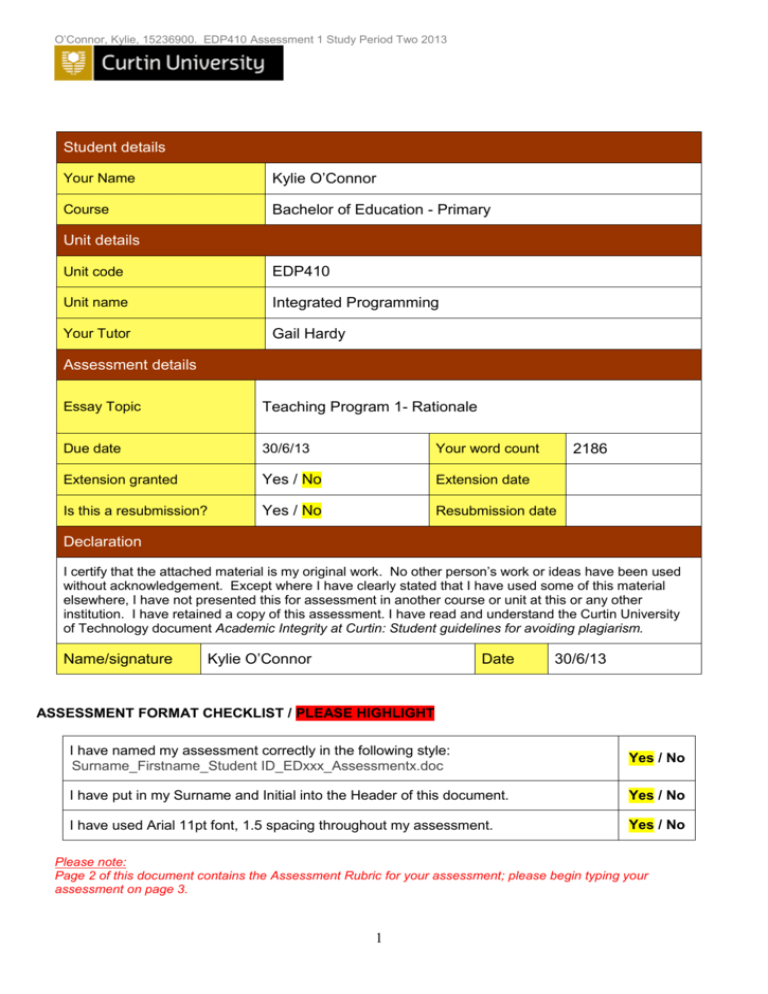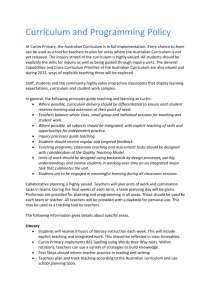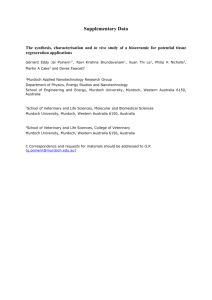EDP410_O - WordPress.com
advertisement

O’Connor, Kylie, 15236900. EDP410 Assessment 1 Study Period Two 2013 Student details Your Name Kylie O’Connor Course Bachelor of Education - Primary Unit details Unit code EDP410 Unit name Integrated Programming Your Tutor Gail Hardy Assessment details Essay Topic Teaching Program 1- Rationale Due date 30/6/13 Your word count Extension granted Yes / No Extension date Is this a resubmission? Yes / No Resubmission date 2186 Declaration I certify that the attached material is my original work. No other person’s work or ideas have been used without acknowledgement. Except where I have clearly stated that I have used some of this material elsewhere, I have not presented this for assessment in another course or unit at this or any other institution. I have retained a copy of this assessment. I have read and understand the Curtin University of Technology document Academic Integrity at Curtin: Student guidelines for avoiding plagiarism. Name/signature Kylie O’Connor Date 30/6/13 ASSESSMENT FORMAT CHECKLIST / PLEASE HIGHLIGHT I have named my assessment correctly in the following style: Surname_Firstname_Student ID_EDxxx_Assessmentx.doc Yes / No I have put in my Surname and Initial into the Header of this document. Yes / No I have used Arial 11pt font, 1.5 spacing throughout my assessment. Yes / No Please note: Page 2 of this document contains the Assessment Rubric for your assessment; please begin typing your assessment on page 3. 1 INSERT UNIT TITLE: ASSESSMENT x (xx%) ASSESSMENT RUBRIC Fail Criteria. Pass Credit Distinction High Distinction Description Description Description Description Description Description Description Description Description Description Description Description Description Description Description Description Description Description Description Description Description Description Description Description Description MARK (x marks) Criteria. (x marks) Criteria. (x marks) Criteria. (x marks) Criteria. (x marks) TOTAL MARK Comment: 0 O’Connor, Kylie, 15236900. EDP410 Assessment 1 Study Period Two 2013 The Use of Integrated Programming in the Classroom Introduction Contemporary learners in the 21st century have specific needs to enable them to become lifelong learners; it is challenge the teacher will need to address to provide them with relevant, meaningful experiences in order for this to occur as they will continue to learn as technology changes around them. Research has shown that students have differing learning styles and opportunities must be presented to cater to this diversity. This is not just for the students to learn, and more importantly develop the understanding; but also for the teacher to continue to learn and develop their ability to engage students in their own learning. This will be done using inquirybased learning as part of integrated learning programs; to accommodate the curriculum requirements, while incorporating a range of rich tasks as assessment for and of learning. According to Murdoch and Hornsby (1997, p.1), an effective integrated curriculum has two main characteristics: It is inquiry based and “structured according to the principles of inquiry teaching and learning.” (Murdoch & Hornsby, 1997. p.1) Is driven by developing understanding, which is the “ultimate goal of teaching and learning” through “enhancing student understanding” of the world and how it works. (Murdoch & Hornsby, 1997. p.1) This has been the basis of the author’s personal philosophy of teaching, however this is constantly evolving as further knowledge is gained as part of the lifelong learning journey. Inquiry learning and problem-based learning discussion Planning of integrate curriculum is time consuming and the beginning of a unit, however as the unit progresses this becomes easier due to its long term focus, as opposed to week-toweek planning. Murdoch & Hornsby (1997, p.5) recommend planning integrated curriculum as a collaborative process, although this requires teachers to be able to meet and plan together in “sustained blocks of time” to expedite the process. Inquiry learning allows for easier integration of the curriculum, as this form of learning encourages “thinking in order to make meaning.” (Murdoch, 2005) Students learn to think and make sense of the world around them through wondering, planning, analysing, creating and reflecting. (Murdoch, 2005) Students use a number of skills and disciplines to develop their understanding as specified in the Australian Curriculum. The seven general capabilities which “encompass the knowledge, skills, behaviours and dispositions that, together with curriculum content in each learning area and the cross-curriculum priorities, will assist students to live and work successfully in the twenty-first century.” (Australian Curriculum, Assessment and Reporting Authority [ACARA], 2013a). There are a number of models that apply Inquiry and problem-based learning, one such being the 5E model which may normally be applied to the Science curriculum, however may also 3 be applied within a lesson or series of lessons. The 5E model is exactly what it states; ‘five distinct but interconnected phases’ for developing student understanding. (Dawson & Venville, 2007. p.116)These five phases are ‘Engage; Explore; Explain; Elaborate and Evaluate’. (Dawson & Venville, 2007. p.116)This model is effective as it allows the teacher to develop lessons which caters to students of all learning abilities. The teacher captures the students’ interest through a thought-provoking activity or question which guides further lessons as students develop their understanding and apply this new knowledge. Problem-based models such as this encourage students to self-evaluate their gained knowledge as well as the teacher assessing their learning. (Dawson & Venville, 2007. p.116) The Big 6 is a problem-solving approach to learning as developed by Michael B. Eisenberg and Robert E. Berkowitz. It has six steps that focus on problem-solving across the curriculum and may be applied to any subject and all ages. The six steps are; ‘Task definition Information seeking strategies, Location and access, Use of information, Synthesis and Evaluation’. (Big 6, 2013) The Big 6 is a literacy process using information literacy and communication processes, or ICT skills as stated in the Australian Curriculum, to help students and teachers solve problems or make decisions by using information. (Big 6, 2013) The Big 6 has been deemed to be too overwhelming for younger students, so has been modified to the Super 3 of Plan, Do and Review to meet their needs. (Big 6, 2013) The Big 6 and Super 3 process is essential for the 21st century learner as it will form a solid foundation of literacy and technology skills that will enable them to move forward and continue to learn in the future. (Big 6, 2013) Wilson and Wing Jan’s (2003) model for learning is inquiry based and has six basic stages; Tuning In; Finding Out, Sorting out, Going Further, Reflection and Action. The purpose of each of these stages is to “provide guidelines for selecting appropriate activities” for students to be engaged in their learning. (Wilson & Wing Jan, 2003) Activities in some stages may need to be repeated or further activities in order for students to make meaning due to the individual learning styles children display. In this model students are “aware of the purpose of their learning” and they are encouraged to pose questions as they develop their understanding. (Murdoch & Hornsby, 1997. p.7) Questioning in inquiry Questioning in inquiry is important for students to develop their understanding. Through questioning, the teacher will discover what the students know and what they need to know, as well as what interests them. This questioning will assist in the planning process as the teacher will be able to plan lessons that are engaging and specific to the needs of the class. There are a number of models that apply questioning in inquiry, with the most recognised Bloom’s Taxonomy; originally developed by Benjamin Bloom in the 1950s. This was re-visited by Lorin Anderson in the 1990s and the wording revised to ensure relevance to the changing needs of students. Bloom’s Revised Taxonomy provides six levels to organise thinking skills from basic O’Connor, Kylie, 15236900. EDP410 Assessment 1 Study Period Two 2013 to higher order levels of thinking. (Tarlinton, 2003) The new terms for the Taxonomy are: creating, evaluating, analysing, applying, understanding and remembering; these terms are verbs and reflect the active role students now play in their learning journey as opposed to being passive learners. (Tarlinton, 2003) Based on the work of James Moffett describing ‘oral language as the essential link for understanding, thinking and literacy’; Marion Blank’s levels of questioning are developed predominately for pre-schoolers.(Wise Words Australia, 2012) The four levels may also be applied effectively with older children indicating ‘delayed or disordered language’ when applied to the planning of integrated curriculums. (Wise Words Australia, 2012) Blank’s Levels of Questioning focus on perception for inquiry learning; Level 1 – matching perception processes; Level 2 – Selective analysis of perception; Level 3 – Reordering perception; and Level 4 – Reasoning about perception. (Wise Words Australia, 2012) This model requires the teacher to recognise the student’s level of understanding and address questions to this level, simplifying as necessary. Information should be restated, varying each time to allow the child opportunities to process and understand the information heard before moving on to the next level. (Wise Words Australia, 2012) Edward de Bono developed the ‘Six Thinking Hats’ tool as a tool for moving beyond habitual thinking styles to allow people to look at situations from a different perspective. Questioning in this manner is a skill for life and this tool is suitable for students to use well into their adult years in many life experiences. The ‘Six Thinking Hats’ process is colour guided for different styles of thinking about problems and solutions, as students move towards higher order thinking. ‘White Hat thinking’ covers information; while the ‘Red Hat’ covers intuition, feeling and emotion; ‘Black Hat’ covers discernment and judgement; ‘Yellow Hat’ refers to optimistic, logical positive feeling to find value in occurrences; ‘Green Hat’ cover creativity and interests; and finally the ‘Blue Hat’ is concerned with meta-cognition or the overview of the subject. (MindTools Ltd, 2013) This model develops student understanding the teacher encourages them to look at the topic from a different perspective; because it is outside their normal thinking ability it may be difficult and cannot be used all the time. The interactive model of learning as developed by Faire & Cosgrove (1988), is one again recommended for Science curriculum but may be applied across an integrated program, and revolves around the questions of students. (Dawson & Venville, 2007. p.117) There are seven stages to this model and they are; ‘Preparation, Before views, Exploratory activities, Student questions, Investigations, After views and Reflections’. (Dawson & Venville, 2007. p.117) This model encourages full student participation in the learning process of a specified topic and activities provide scope and opportunity for further questioning and stimulation. The reflection process allows the students to suggest what their findings are and any information that may still 5 be determined. (Dawson & Venville, 2007. p.117) This model provides opportunity for group and collaborative work, building further life skills in their learning journey; while providing the teacher with opportunity for formative assessment and adjusting further lessons to suit student requirements. Use of integrated learning tasks The Australian Curriculum is outcomes-based, however when planning the focus should be on the content to be taught rather than the intended outcome. Modern classrooms have a vast range of differences between learning styles and abilities, gender and religion, as well as students from a multitude of cultural backgrounds, all with very individual learning needs.(Reif & Heimburge, 2006) The use of integrated learning tasks allows for sustainable education, providing students with the skills required by them as contemporary learners to thrive in the modern world. According to Murdoch and Hornsby (1997), the use of integrated learning tasks following the curriculum will allow for greater cohesion as students and teachers will be able to make connections; between subjects and being able to apply to life experiences. When the curriculum is integrated the learner is able to ‘make connections that transcend the boundaries of subject-specific knowledge’ by actively involving students in their own learning. (Murdoch & Hornsby, 1997. p.8) An integrated program allows the teacher to better utilise the time available for learning, as ‘knowledge, skills, values and actions are integrated towards a common purpose.’ (Murdoch and Hornsby, 1997. p.7) The important thing to remember when planning integrated units of work is the focus on significant content, which lends itself to inquiry. While the use of a range of processes to explore this content will ensure deeper understanding, the use of focus question with a broad scope for the anticipated outcomes will provide the direction for the integrated learning program. (Clarke, 2002. p.81) Each learning area is accommodated and the learner should be given “multiple forms of expression and perception”. (Murdoch & Hornsby. 1997. p.7) Collaboration between teachers when planning for an integrated unit of work will share a wealth of knowledge and understanding; which will benefit both the learner and the teacher throughout the entire program. Use of rich tasks as assessment for learning and assessment of learning Rich tasks should be used for students as both an assessment for learning and an assessment of learning. It is imperative for the teacher to provide more than one opportunity for students to demonstrate their learning with a variety of assessment options for students. Essentially in every classroom assessment is ongoing and the teacher should ensure careful planning for experiences suitable to individual needs, as well as documenting their assessments to ensure they are able to adapt their program to accommodate any misconceptions that arise. (Tomlinson, 1999) When choosing rich tasks three criteria are used to judge their value; “focus on O’Connor, Kylie, 15236900. EDP410 Assessment 1 Study Period Two 2013 learning a discipline, connections to a real-world context and accessibility to students”. (Moulds, 2003. p.76) The Australian Curriculum allows plenty of scope for rich tasks as assessment for learning and assessment of learning. A year 3 integrated program on Community and Remembrance asks the questions “How has our community changed? What features have been lost and what features have been retained?” (Australian Curriculum, Assessment and Reporting Authority [ACARA], 2013b) An example of a rich task could be an excursion to local historical landmarks. Following this, students will research a chosen landmark from those visited, and create a PowerPoint presentation to present to the class in pairs with an accompanying speech outlining the changes that have occurred over time around this landmark. Students may also then choose to predict the changes for the future and how they influence those changes through their actions. Students could write a letter to their local council suggesting ways to preserve their chosen landmark or surrounding area. Students may map the local area by “Creating and interpreting simple grid maps to show position and pathways”. (Australian Curriculum, Assessment and Reporting Authority [ACARA], 2013c) This program will integrate aspects of English and Mathematics; as well as Science and Geography. Conclusion The use of integrated learning programs in modern classrooms allows teachers to present students with relevant, meaningful experiences in order for them to develop their understanding as well as thinking skills. In this manner contemporary learners in the 21st century will develop the necessary skills for life-long learning through opportunities for learning for their differing learning styles and needs. The use of inquiry-based integrated programs will allow the teacher to reflect on their teaching, and continue their own learning how best to meet the needs of their students. With ongoing assessment and flexibility, teachers will continue to provide rich learning experiences for students while addressing the requirements of the curriculum. References Australian Curriculum, Assessment and Reporting Authority [ACARA]. (2013a). The Australian Curriculum v5.0 General capabilities - General capabilities in the Australian Curriculum. Retrieved from http://www.australiancurriculum.edu.au/GeneralCapabilities/Overview/Generalcapabilities-in-the-Australian-Curriculum 7 Australian Curriculum, Assessment and Reporting Authority [ACARA]. (2013b) The Australian Curriculum v5.0 History Foundation to Year 10 Curriculum. Retrieved from http://www.australiancurriculum.edu.au/History/Curriculum/F-10 Australian Curriculum, Assessment and Reporting Authority [ACARA]. (2013c) The Australian Curriculum v5.0 Mathematics Foundation to Year 10 Curriculum. Retrieved from http://www.australiancurriculum.edu.au/Mathematics/Curriculum/F-10 Big 6. (2013). The Big 6: Information & Technology Skills for Student Success. Retrieved from http://big6.com/ Clark, E.T. (2002). Designing and implementing an integrated approach: A student-centered approach. Brandon, VT: Psychology Press. Dawson, V. & Venville, G. (2007). The art of teaching primary science. Crows Nest, Australia: Allen & Unwin. Hurst, C. (2012) Integrated Progrtamming 410 – Topic 3. [PowerPoint Slides]. Retrieved from Curtin University https://lms.curtin.edu.au/bbcswebdav/pid-2532938-dt-content-rid7827474_1/xid-7827474_1 Mind Tools Ltd. (2013). Six Thinking Hats. Retrieved from http://www.mindtools.com/pages/article/newTED_07.htm Moulds, P. (2003). Rich Tasks. Education leadership. December 2003/January 2004. Association for Supervision & Curriculum Development. Retrieved from http://imoberg.com/files/Rich_Tasks_Moulds_P._.pdf Murdoch, K. (2005). Inquiry learning- journeys through the thinking processes. Retrieved from http://www.kathmurdoch.com.au/uploads/media/inquirylearning.pdf Murdoch, K., & Hornsby, D. (1997). Planning curriculum connections: Whole-school planning for integrated curriculum. Victoria, Australia: Eleanor Curtain Publishing. Reif., S & Heimburge, J. (2006). How to reach & teach all children in the inclusive classroom: Practical strategies, lessons and activities (2nd ed). San Francisco, CA: Jossey-Bass Tarlinton, D. (2003). Bloom’s Revised Taxonomy.[PowerPoint Slides]. Retrieved from Curtin University https://lms.curtin.edu.au/courses/1/313476-Vice-Chancello180741249/content/_2532938_1/blooms%20pres%20ppt%20doc%201.ppt Tomlinson, C.A. (1999). The differentiated classroom: responding to the needs of all learners. Alexandria, Virginia: Association for Supervision and Curriculum Development. pp. 15-16 Wilson, J., & Wing Jan, L. (2003). Focus on inquiry: A practical approach to integrated curriculum planning. Carlton: Curriculum Corporation. Wise Words Australia. (2012). Marion Blank: Blank’s Levels of Questioning. Retrieved from http://www.wisewordsaustralia.com.au/ O’Connor, Kylie, 15236900. EDP410 Assessment 1 Study Period Two 2013 9







